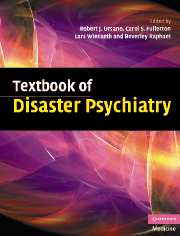Book contents
- Frontmatter
- Contents
- List of contributors
- Preface
- Part I Introduction
- Part II Foundations of disaster psychiatry
- Part III Clinical care and interventions
- 6 Early intervention for trauma-related problems following mass trauma
- 7 Acute stress disorder and post-traumatic stress disorder in the disaster environment
- 8 Assessment and management of medical-surgical disaster casualties
- 9 Interventions for acutely injured survivors of individual and mass trauma
- 10 Nongovernmental organizations and the role of the mental health professional
- Part IV Special topics
- Part V Public health and disaster psychiatry
- Index
- References
7 - Acute stress disorder and post-traumatic stress disorder in the disaster environment
from Part III - Clinical care and interventions
Published online by Cambridge University Press: 09 August 2009
- Frontmatter
- Contents
- List of contributors
- Preface
- Part I Introduction
- Part II Foundations of disaster psychiatry
- Part III Clinical care and interventions
- 6 Early intervention for trauma-related problems following mass trauma
- 7 Acute stress disorder and post-traumatic stress disorder in the disaster environment
- 8 Assessment and management of medical-surgical disaster casualties
- 9 Interventions for acutely injured survivors of individual and mass trauma
- 10 Nongovernmental organizations and the role of the mental health professional
- Part IV Special topics
- Part V Public health and disaster psychiatry
- Index
- References
Summary
Introduction
Post-traumatic stress disorder (PTSD) is an often severe, chronic, and disabling mental disorder that may develop after exposure to a traumatic event (or events) as may occur in disasters. Acute stress disorder (ASD) is characterized by similar – but transient – symptoms. Given their potential to result in widespread distress and dysfunction, PTSD and ASD deserve special consideration in disaster preparedness and response plans.
Beyond duration of symptoms, ASD is distinguished from PTSD by a diagnostic requirement for symptoms of peritraumatic dissociation. While ASD does not inevitably portend the later development of PTSD, dissociation may be the best predictor of the subsequent development of PTSD (Harvey & Bryant, 1998). Both PTSD and ASD are characterized by specific symptoms organized into core clusters of re-experience, hyperarousal, and avoidance/numbing. The common and distinguishing characteristics of the two disorders are described in the following section of this chapter, “Clinical presentation.” Since other mental disorders (e.g., depression, substance abuse), stress reactions, and both acute and chronic distress-related behavioral changes not amounting to diagnosable disorders contribute greatly to the public health burden of disaster and often co-occur, the differential diagnosis and features associated with ASD and PTSD are also reviewed.
The atmosphere of chaos, disruption, unanticipated injury, loss, and death created by any disaster will establish a population meeting the traumatic exposure threshold criterion necessary – but not sufficient – for the development of ASD or PTSD. The section of this chapter entitled “Epidemiology” highlights the idea that many individuals exposed to significant trauma do not develop ASD or PTSD and describes subgroups that may be at greater risk for these conditions in the aftermath of disaster.
Keywords
- Type
- Chapter
- Information
- Textbook of Disaster Psychiatry , pp. 140 - 163Publisher: Cambridge University PressPrint publication year: 2007
References
- 1
- Cited by



